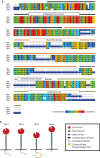The impact of the TIM gene family on tumor immunity and immunosuppression
- PMID: 24336162
- PMCID: PMC4002149
- DOI: 10.1038/cmi.2013.57
The impact of the TIM gene family on tumor immunity and immunosuppression
Abstract
Tumor immunoevasion is an advanced phase of cancer immunosurveillance in which tumor cells acquire the ability to circumvent host immune systems and exploit protumorigenic inflammation. T-cell immunoglobulin mucin (TIM) gene family members have emerged as critical checkpoint proteins that regulate multiple immune response phases and maintain immune homeostasis. Accumulating evidence demonstrates that tumor cells exploit TIM gene family members to evade immunosurveillance, whereas TIM gene family members facilitate the prevention of inflammation-related tumor progression. Thus, a comprehensive analysis to clarify the relative contributions of TIM gene family members in tumor progression may elucidate immunosurveillance systems in cancer patients.
Figures



Similar articles
-
TIM family of genes in immunity and tolerance.Adv Immunol. 2006;91:227-49. doi: 10.1016/S0065-2776(06)91006-2. Adv Immunol. 2006. PMID: 16938542 Review.
-
Oncolytic adenovirus decreases the proportion of TIM-3+ subset of tumor-infiltrating CD8+ T cells with correlation to improved survival in patients with cancer.J Immunother Cancer. 2022 Feb;10(2):e003490. doi: 10.1136/jitc-2021-003490. J Immunother Cancer. 2022. PMID: 35193929 Free PMC article.
-
T cell immunoglobulin and mucin domain protein 3 inhibits glycolysis in RAW 264.7 macrophages through Hexokinase 2.Scand J Immunol. 2021 Feb;93(2):e12981. doi: 10.1111/sji.12981. Epub 2020 Oct 24. Scand J Immunol. 2021. PMID: 33031600
-
Tim-3, a negative regulator of anti-tumor immunity.Curr Opin Immunol. 2012 Apr;24(2):213-6. doi: 10.1016/j.coi.2011.12.005. Epub 2012 Jan 4. Curr Opin Immunol. 2012. PMID: 22226204 Review.
-
The structure, expression, and multifaceted role of immune-checkpoint protein VISTA as a critical regulator of anti-tumor immunity, autoimmunity, and inflammation.Cell Mol Immunol. 2018 May;15(5):438-446. doi: 10.1038/cmi.2017.148. Epub 2018 Jan 29. Cell Mol Immunol. 2018. PMID: 29375120 Free PMC article. Review.
Cited by
-
Distinct role of Tim-3 in systemic lupus erythematosus and clear cell renal cell carcinoma.Int J Clin Exp Med. 2015 May 15;8(5):7029-38. eCollection 2015. Int J Clin Exp Med. 2015. PMID: 26221240 Free PMC article.
-
TIM-4 is differentially expressed in the distinct subsets of dendritic cells in skin and skin-draining lymph nodes and controls skin Langerhans cell homeostasis.Oncotarget. 2016 Jun 21;7(25):37498-37512. doi: 10.18632/oncotarget.9546. Oncotarget. 2016. PMID: 27224924 Free PMC article.
-
Directed protein engineering identifies a human TIM-4 blocking antibody that enhances anti-tumor response to checkpoint inhibition in murine colon carcinoma.Antib Ther. 2024 Sep 23;7(4):324-334. doi: 10.1093/abt/tbae026. eCollection 2024 Oct. Antib Ther. 2024. PMID: 39678260 Free PMC article.
-
TIM-4 is expressed on invariant NKT cells but dispensable for their development and function.Oncotarget. 2016 Nov 1;7(44):71099-71111. doi: 10.18632/oncotarget.12153. Oncotarget. 2016. PMID: 27662666 Free PMC article.
-
Engineering Platforms for T Cell Modulation.Int Rev Cell Mol Biol. 2018;341:277-362. doi: 10.1016/bs.ircmb.2018.06.003. Epub 2018 Jul 30. Int Rev Cell Mol Biol. 2018. PMID: 30262034 Free PMC article. Review.
References
-
- Pardoll D. Does the immune system see tumors as foreign or self. Annu Rev Immunol. 2003;21:807–839. - PubMed
-
- Vesely MD, Kershaw MH, Schreiber RD, Smyth MJ. Natural innate and adaptive immunity to cancer. Annu Rev Immunol. 2011;29:235–271. - PubMed
-
- Mantovani A, Allavena P, Sica A, Balkwill F. Cancer-related inflammation. Nature. 2008;9:361–371. - PubMed
Publication types
MeSH terms
Substances
LinkOut - more resources
Full Text Sources
Other Literature Sources

